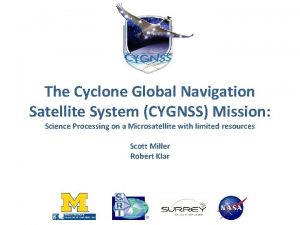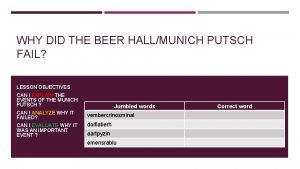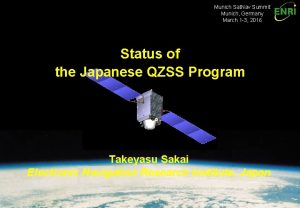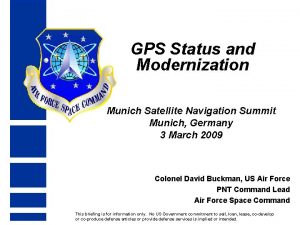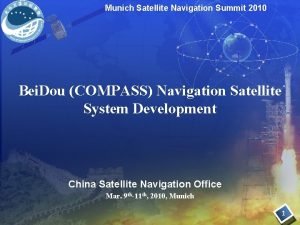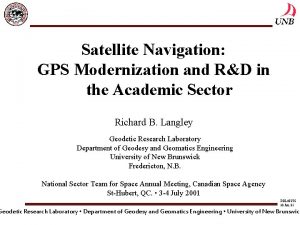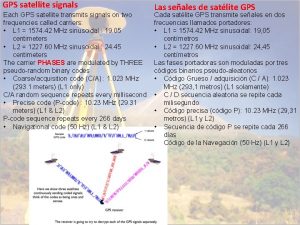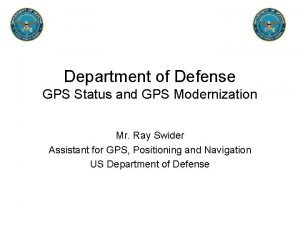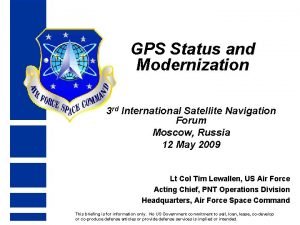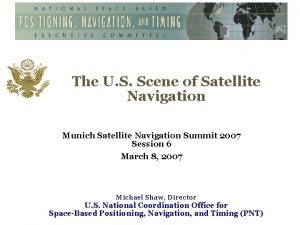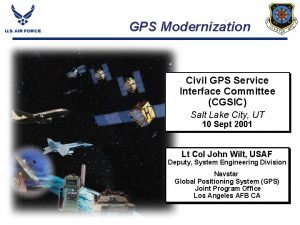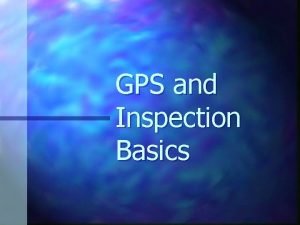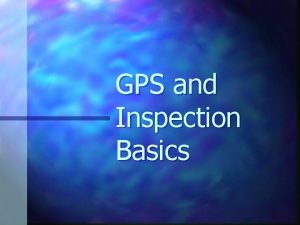GPS Status and Modernization Munich Satellite Navigation Summit















- Slides: 15

GPS Status and Modernization Munich Satellite Navigation Summit Munich, Germany 20 Feb 2008 Lt Col Harold Martin, US Air Force PNT Command Lead Air Force Space Command This briefing is for information only. No US Government commitment to sell, loan, lease, co-develop or co-produce defense articles or provide defense services is implied or intended.

Overview • • GPS Status Recent Modernization Improvements The Future Summary 2

GPS – Serving the World • Constellation– the largest ever- 30 Healthy Satellites • 13 Block IIA • 12 Block IIR • 5 Block IIR-M • • Most Recent Launch • • • 31 st satellite, SVN 23, still has a good clock – AF working to see if it can be set healthy to achieve 31 healthy satellite constellation for first time ever IIR-18(M) – 5 th modernized SV • Launched Wednesday, 20 Dec 07 • SVN 57, PRN 29, slot C 1 • Set healthy on 2 Jan 08 Next Launches • IIR-19(M) – Mar 08 • IIR-20(M) – Jun 08 – L 5 demo payload • IIR-21(M) - Sep 08 IIF-1 launch in Spring 09 3

GPS – Spectrum Block IIA 1990 Block IIR 1997 Previous since Dec 2005 (5 SVs) Block IIR-M, 2005 Planned Block IIF, 2009 Block III, 2014 (artist’s concept) ARNS Band RNSS Band ARNS Band 4

GPS Status – Serving the World • • Performance – Our best ever accuracy Current Performance Average URE from 30 GPS SVs: 0. 51 m Source: JPL 2/10/2008 5

GPS Status – Serving the World • Recent Modernization Improvements: • Launched 5 th of 8 Block IIR-M satellites • Architecture Evolution Plan – transition to a new Command Control System at 2 SOPS for dayto-day operations • Launch, Anomaly and Disposal Operations (LADO) - transitioned from 1 SOPS to 2 SOPS 6

Recent Modernization Improvements • 5 Block IIR-M Satellites on orbit now: • Second Civilian Signal, L 2 C • • • L 2 C provides increased accuracy for civilian receivers: applications from precision farming to construction surveying 5 th satellite means more L 2 C coverage around the globe Dual frequency receivers reduce ionospheric errors Better performing atomic clocks than IIA IIR-M 20 will fly a demonstration payload with an L 5 signal 7

Recent Modernization Improvements • Architecture Evolution Plan (AEP) • New Master Control Station operational Sep 14, 2007 • • • New Alternate Master Control Station at Vandenberg AFB, CA Increased capacity to monitor satellites • • • Modern distributed system replaced 1970’s era mainframe Utilizes dedicated Monitor Stations and NGA Monitor Stations to allow increased monitoring of GPS signals Increased worldwide coverage to 100 % (was 96. 4%) and have 99. 8% of world double covered Utilizes dedicated GPS Ground Antennas and allows use of 8 Air Force Satellite Control Network remote sites for increased commanding capability • Increased worldwide commanding capability daily from 92. 7% of the time to 94. 5% while providing nearly double the backup capability 8

Recent Modernization Improvements • Launch, Anomaly and Disposal Operations (LADO) • • • Transitioned capability from 1 SOPS to 2 SOPS - centralizes GPS operations into a single unit Replaces 90’s mainframe based system with increased use of modern distributed technology with electronic technical orders while decreasing the maintenance burden Used for launch of IIRM-17 on Oct 17, 2007 and IIRM-18 on Dec 20, 2007 9

The Future of GPS 21/02/2021

Future of GPS – Block IIF Satellites • • • Program Description • 2 Rb + 1 Cs clocks • 12 year design life • Launch Atlas V or Delta IV • Satellite launch weight ~ 3720 lbs • PPS Signals: L 1 -L 2 P(Y), L 1 L 2 M-code SPS Signals: L 1 C/A, L 2 C, and L 5 • L 5 will provide second civil unique frequency in protected band Program Status: • SV 1 in qualification tests • Delivery to Cape Dec 08 • First launch 2009 11

Future of GPS – Block III Satellites • • • Program Description: • • GPS IIIA includes all GPS IIRM/IIF capabilities, plus: Enhanced earth coverage Mcode power (10 x) enables improved operations in jammed & austere environments GPS III guarantees 4 x better User Range Error than IIF • GPS signal-in-space improves from <3 m to <1 m GPS III Integrity guarantee supports safety-of-life applications • Probability of Misleading Signal-in-space Information (MSI) <0. 0001/hr (Threshold) • New L 1 C civil signal interoperable with Galileo/QZSS Aggressive Capability Insertion Program to mature capabilities • Directional crosslink demo by IIIA; baselined on IIIB • High Power Spot Beam demo by IIIB; baselined on IIIC • Provides 20 d. B (100 Xs) greater M-code power Program Status: • Implementing “Block” approach to incrementally respond to warfighter capability requirements – reduces risk • Contract in Source Selection, expect award Spring 08 12

The Future of GPS – New C 2 System • Next Generation Operational Control Segment (OCX) • • • Enables modernized messaging Controls more capable GPS constellation Monitors all GPS signals Two development contracts awarded – 21 Nov 07 Air Force Space Command (AFSPC) is standing up a Community of Interest (COI) to implement net-centric operations using OCX • GPS COI is a forum for users to recommend the data and services that should accessible from the global information grid (GIG) 13

The Future of GPS – User Equipment • Comm/Nav/Network Fusion • Benefit in comm/nav user equipment integration • Better accuracy, reduced time uncertainty, data stripping, network interference detection/location • A variety of approaches to comm/nav integration exist today and should be studied further • Additional investment and prototyping is required • Chip Scale Atomic Clocks • Software defined receiver 14

Summary • • • Largest constellation in history with best accuracy ever Modernized Command Control System allows more signal monitoring and quicker satellite commanding than ever before And we’re continuing to modernize and improve GPS even more! GPS – Serving the World as the Gold Standard in Space Based Navigation 15
 Gps gps gps
Gps gps gps Modulo positioning
Modulo positioning Cyclone global navigation satellite system
Cyclone global navigation satellite system Difference between modernisation and globalisation
Difference between modernisation and globalisation The courtyard of the old residency in munich
The courtyard of the old residency in munich Munich weather radar
Munich weather radar Munich germany currency
Munich germany currency Hitler knight
Hitler knight Why did the munich putsch fail
Why did the munich putsch fail Munich parking zones
Munich parking zones Olching germany bombing
Olching germany bombing Munich re natcatservice
Munich re natcatservice Autoportrait (dürer, munich)
Autoportrait (dürer, munich) Munich hotels oktoberfest
Munich hotels oktoberfest Sat to munich
Sat to munich What year was the treaty of versailles signed
What year was the treaty of versailles signed


